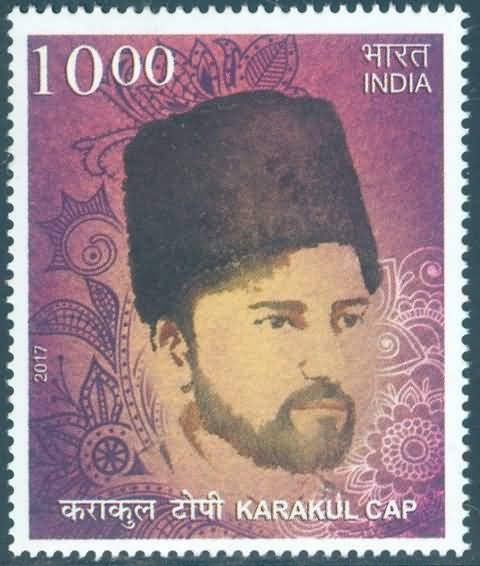Karakul, Kashmiri Cap

Technical Data
| Stamp Set | Headgears of India |
|---|---|
| Date of Issue | February 10, 2017 |
| Denomination | Rs. 10 |
| Quantity | 300,000 |
| Perforation | 14¼ |
| Printer | Security Printing Press, Hyderabad |
| Printing Process | Wet Offset |
| Watermark | No Watermark |
| Colors | Multicolor |
| Credit (Designed By) | Ms. Gulistaan |
| Catalog Codes |
Michel IN 3109 Yvert et Tellier IN 2801 Stanley Gibbons IN 3269 |
| Themes | Clothing | Customs | Headgear | Suits and Costumes |
The Elegance of Heritage and Honour from the Valley
The Kashmiri Cap, also known as the Karakul Cap, is one of the most distinctive symbols of cultural identity and traditional pride from the beautiful valley of Kashmir. This elegant headgear embodies not only the timeless charm of the region but also its deep-rooted sense of dignity, honour, and tradition.
A Symbol of Pride and Dignity
In Kashmir, wearing a cap or turban has long been associated with respect, honour, and cultural pride. The Karakul Cap, traditionally worn by men, reflects the wearer’s social standing and sense of identity. It is often seen during religious ceremonies, weddings, and important social occasions, where it is worn with pride as a mark of respect.
At the most revered shrines of Kashmir, priests and elders adorn the turban or cap as a sign of piety and devotion. In rural areas, though its everyday use has declined, the Karakul Cap remains an essential part of traditional attire during significant festivals and gatherings.
Design and Craftsmanship
The Kashmiri Cap is known for its refined craftsmanship and elegant design. It is generally found in two distinct shapes — the collapsible boat-shaped form and the hard elliptical shape, both crafted with great precision. The Karakul, made from the soft fur of the Karakul sheep, is prized for its fine texture and graceful appearance.
The cap’s subtle hues — usually shades of black, brown, or grey — complement the traditional Kashmiri attire, adding an air of sophistication and understated nobility. Whether paired with the traditional pheran or modern wear, the Karakul Cap continues to exude an aura of heritage and grace.
Cultural Significance
Beyond being a mere accessory, the Karakul Cap represents the soul of Kashmiri culture. It stands for warmth, wisdom, and respect — values deeply ingrained in the ethos of the people of the valley. Historically, it has been worn by spiritual leaders, scholars, and statesmen, further elevating its symbolic importance.
The cap also became internationally recognized when prominent leaders from the region and across the country were often seen wearing it, making it a symbol of Kashmiri identity and refinement.
Commemorative Stamp
Recognizing the artistic and cultural significance of this iconic headgear, the Department of Posts issued a commemorative stamp on the Kashmiri Cap (Karakul Cap) as part of its “Headgears of India” philatelic series. This stamp honours the craftsmanship and heritage of Kashmir, celebrating the cap as an enduring emblem of regional identity and national diversity.
A Crown of Cultural Elegance
The Kashmiri Cap remains a timeless representation of honour, heritage, and pride. It connects the people of Kashmir to their rich past while continuing to inspire reverence in the present. Through the Department of Posts’ commemorative stamp, this elegant headgear stands immortalized as one of India’s most graceful cultural treasures — a true crown of the valley.
First Day Cover


Leave a Comment
You must be logged in to post a comment.